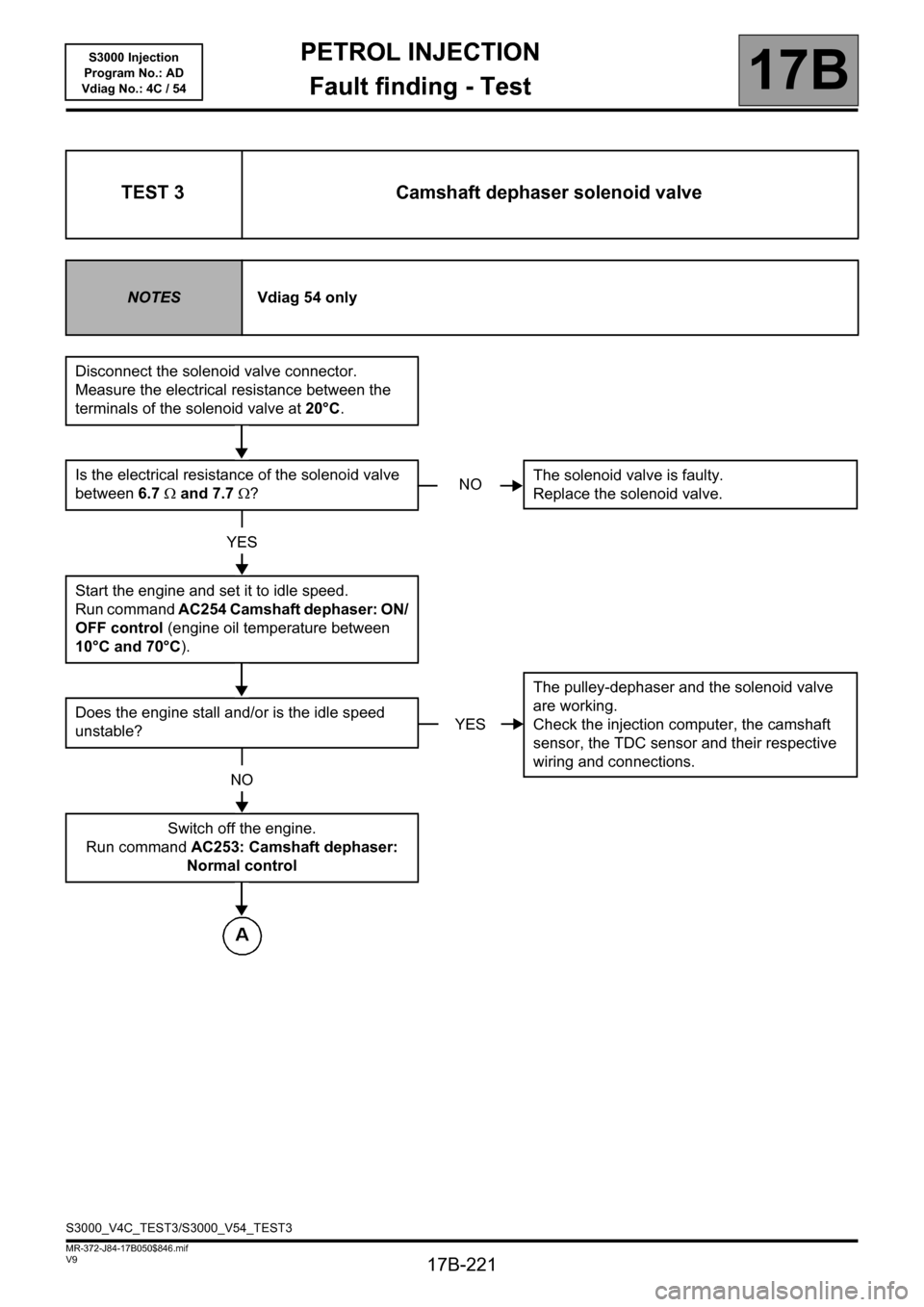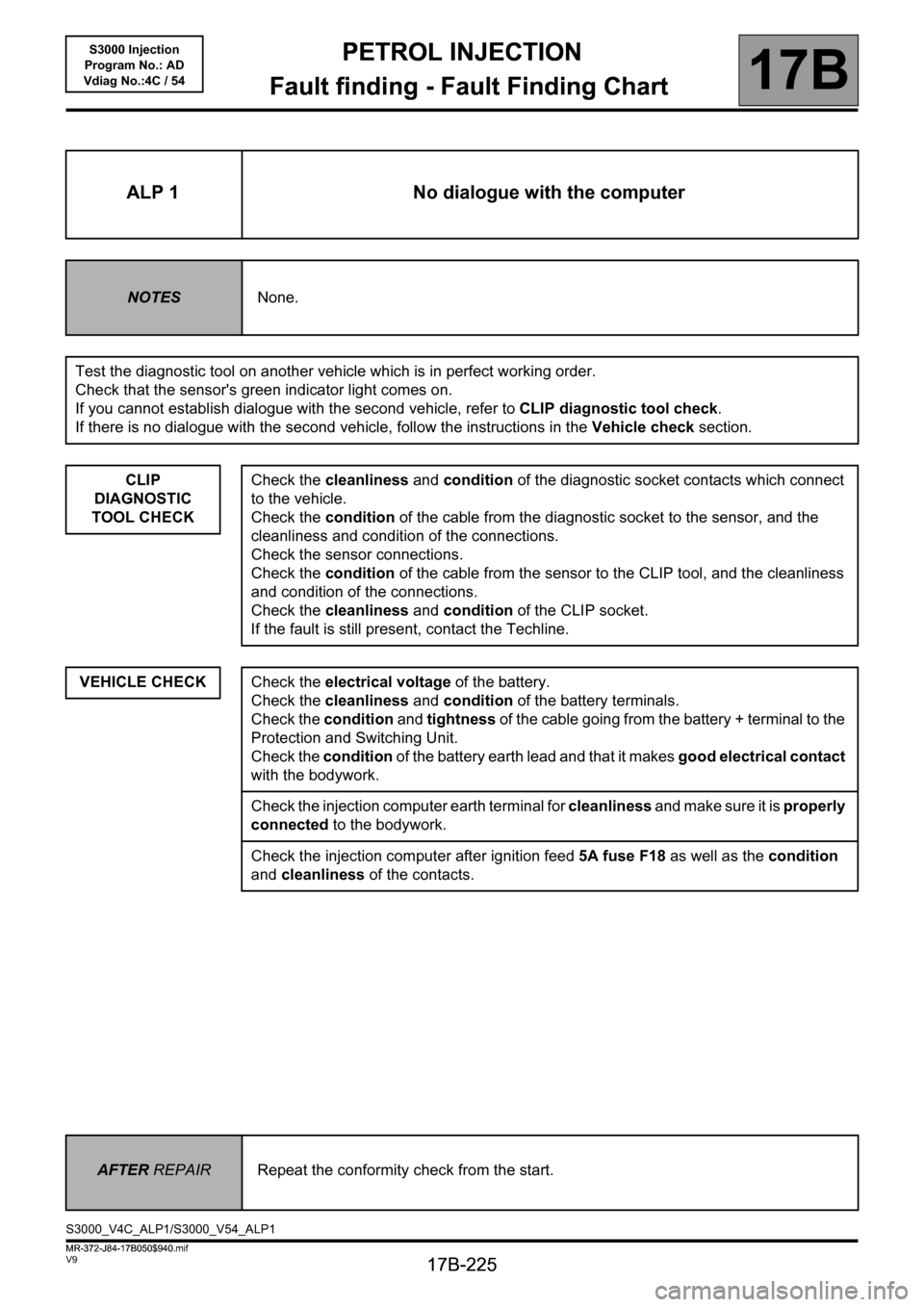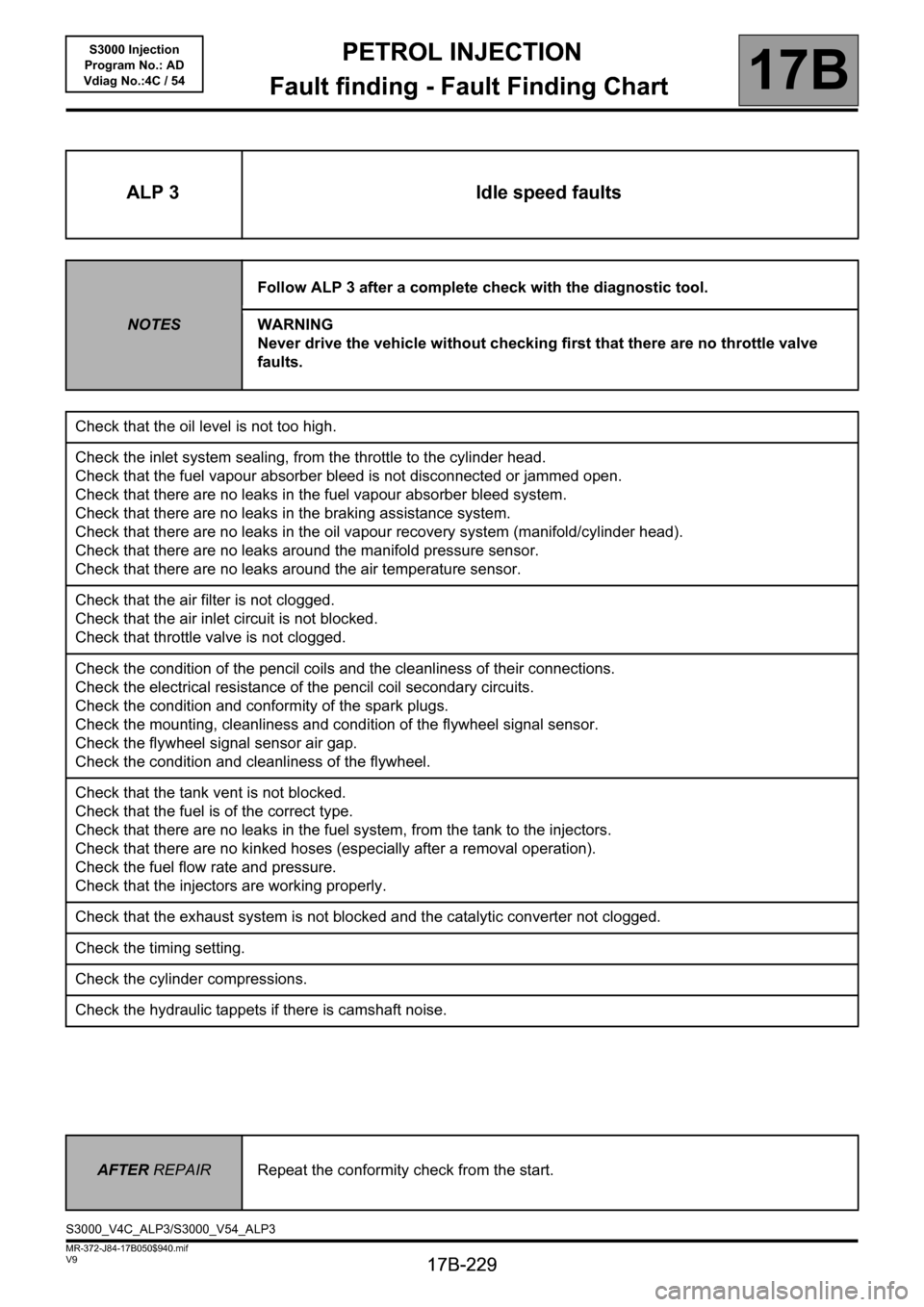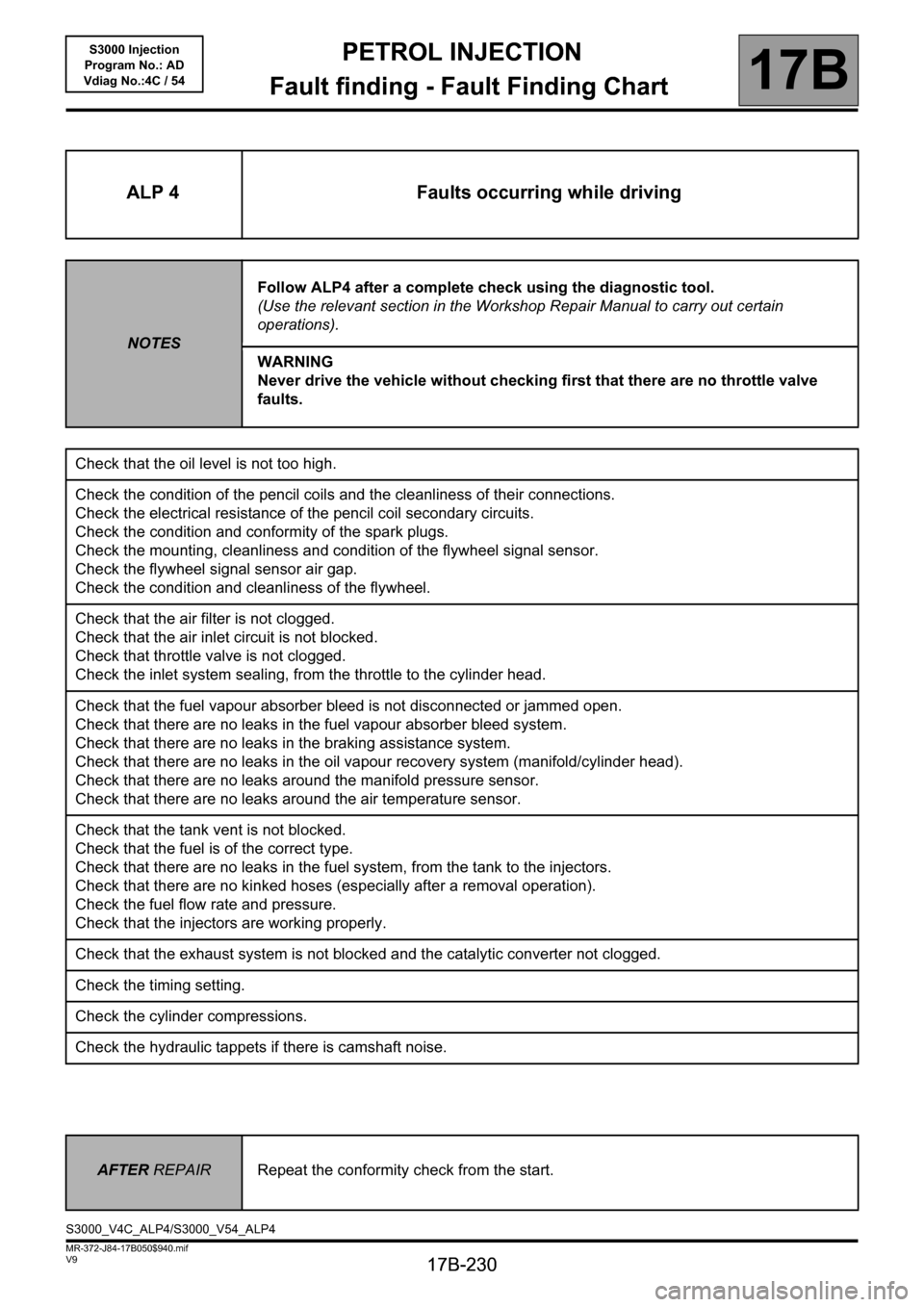sensor RENAULT SCENIC 2010 J95 / 3.G Petrol Injection S3000 Injection Workshop Manual
[x] Cancel search | Manufacturer: RENAULT, Model Year: 2010, Model line: SCENIC, Model: RENAULT SCENIC 2010 J95 / 3.GPages: 230, PDF Size: 0.92 MB
Page 221 of 230

PETROL INJECTION
Fault finding - Test
17B
PETROL INJECTION
Fault finding - Test
17B
17B-221V9 MR-372-J84-17B050$846.mif
S3000 Injection
Program No.: AD
Vdiag No.: 4C / 54
TEST 3 Camshaft dephaser solenoid valve
NOTESVdiag 54 only
Disconnect the solenoid valve connector.
Measure the electrical resistance between the
terminals of the solenoid valve at 20°C.
Is the electrical resistance of the solenoid valve
between 6.7 Ω and 7.7 Ω?
YES
Start the engine and set it to idle speed.
Run command AC254 Camshaft dephaser: ON/
OFF control (engine oil temperature between
10°C and 70°C).
Does the engine stall and/or is the idle speed
unstable?
NO
Switch off the engine.
Run command AC253: Camshaft dephaser:
Normal control
NOThe solenoid valve is faulty.
Replace the solenoid valve.
YESThe pulley-dephaser and the solenoid valve
are working.
Check the injection computer, the camshaft
sensor, the TDC sensor and their respective
wiring and connections.
S3000_V4C_TEST3/S3000_V54_TEST3
Page 225 of 230

PETROL INJECTION
Fault finding - Fault Finding Chart
17B
17B-225
PETROL INJECTION
Fault finding - Fault Finding Chart
17B
17B-225V9 MR-372-J84-17B050$940.mif
S3000 Injection
Program No.: AD
Vdiag No.:4C / 54PETROL INJECTION
Fault finding - Fault Finding Chart
ALP 1 No dialogue with the computer
NOTESNone.
Test the diagnostic tool on another vehicle which is in perfect working order.
Check that the sensor's green indicator light comes on.
If you cannot establish dialogue with the second vehicle, refer to CLIP diagnostic tool check.
If there is no dialogue with the second vehicle, follow the instructions in the Vehicle check section.
CLIP
DIAGNOSTIC
TOOL CHECK
VEHICLE CHECK
Check the cleanliness and condition of the diagnostic socket contacts which connect
to the vehicle.
Check the condition of the cable from the diagnostic socket to the sensor, and the
cleanliness and condition of the connections.
Check the sensor connections.
Check the condition of the cable from the sensor to the CLIP tool, and the cleanliness
and condition of the connections.
Check the cleanliness and condition of the CLIP socket.
If the fault is still present, contact the Techline.
Check the electrical voltage of the battery.
Check the cleanliness and condition of the battery terminals.
Check the condition and tightness of the cable going from the battery + terminal to the
Protection and Switching Unit.
Check the condition of the battery earth lead and that it makes good electrical contact
with the bodywork.
Check the injection computer earth terminal for cleanliness and make sure it is properly
connected to the bodywork.
Check the injection computer after ignition feed 5A fuse F18 as well as the condition
and cleanliness of the contacts.
AFTER REPAIRRepeat the conformity check from the start.
S3000_V4C_ALP1/S3000_V54_ALP1
MR-372-J84-17B050$940.mif
Page 228 of 230

PETROL INJECTION
Fault finding - Fault Finding Chart
17B
17B-228
PETROL INJECTION
Fault finding - Fault Finding Chart
17B
17B-228V9 MR-372-J84-17B050$940.mif
S3000 Injection
Program No.: AD
Vdiag No.:4C / 54
ALP 2 The engine will not start
NOTESFollow ALP 2 after a complete check with the diagnostic tool.
WARNING
Never drive the vehicle without checking first that there are no throttle valve
faults.
If the starter motor does not engage, there may be an engine immobiliser fault.
Carry out fault finding on the UCH (see87B, Passenger Compartment Connection Unit).
Check the condition of the battery.
Check the cleanliness, condition and tightness of the battery terminals.
Check that the battery is correctly earthed to the vehicle bodywork.
Check that the + battery leads are correctly connected.
Check that the starter motor is properly connected.
Check the starter is working properly (see Technical Note 6014A Checking the charging circuit).
Check the condition and conformity of the spark plugs.
Check the mounting, cleanliness and condition of the flywheel signal sensor.
Check the flywheel signal sensor air gap.
Check the condition of the flywheel.
Check that the air filter is not clogged.
Check that the air inlet circuit is not blocked.
Check that there is fuel in the tank (fuel sender fault).
Check that the tank vent is not blocked.
Check that the fuel is of the correct type.
Check that there are no leaks in the fuel system, from the tank to the injectors.
Check that there are no kinked hoses (especially after a removal operation).
Check the fuel flow rate and pressure.
Check the sealing of the injectors, and that they are working properly.
Check that the exhaust system is not blocked and the catalytic converter not clogged.
Check the timing setting.
Check the cylinder compressions.
Check the hydraulic tappets if there is camshaft noise.
AFTER REPAIRRepeat the conformity check from the start.
S3000_V4C_ALP2/S3000_V54_ALP2
Page 229 of 230

PETROL INJECTION
Fault finding - Fault Finding Chart
17B
17B-229
PETROL INJECTION
Fault finding - Fault Finding Chart
17B
17B-229V9 MR-372-J84-17B050$940.mif
S3000 Injection
Program No.: AD
Vdiag No.:4C / 54
ALP 3 Idle speed faults
NOTESFollow ALP 3 after a complete check with the diagnostic tool.
WARNING
Never drive the vehicle without checking first that there are no throttle valve
faults.
Check that the oil level is not too high.
Check the inlet system sealing, from the throttle to the cylinder head.
Check that the fuel vapour absorber bleed is not disconnected or jammed open.
Check that there are no leaks in the fuel vapour absorber bleed system.
Check that there are no leaks in the braking assistance system.
Check that there are no leaks in the oil vapour recovery system (manifold/cylinder head).
Check that there are no leaks around the manifold pressure sensor.
Check that there are no leaks around the air temperature sensor.
Check that the air filter is not clogged.
Check that the air inlet circuit is not blocked.
Check that throttle valve is not clogged.
Check the condition of the pencil coils and the cleanliness of their connections.
Check the electrical resistance of the pencil coil secondary circuits.
Check the condition and conformity of the spark plugs.
Check the mounting, cleanliness and condition of the flywheel signal sensor.
Check the flywheel signal sensor air gap.
Check the condition and cleanliness of the flywheel.
Check that the tank vent is not blocked.
Check that the fuel is of the correct type.
Check that there are no leaks in the fuel system, from the tank to the injectors.
Check that there are no kinked hoses (especially after a removal operation).
Check the fuel flow rate and pressure.
Check that the injectors are working properly.
Check that the exhaust system is not blocked and the catalytic converter not clogged.
Check the timing setting.
Check the cylinder compressions.
Check the hydraulic tappets if there is camshaft noise.
AFTER REPAIRRepeat the conformity check from the start.
S3000_V4C_ALP3/S3000_V54_ALP3
Page 230 of 230

PETROL INJECTION
Fault finding - Fault Finding Chart
17B
17B-230
PETROL INJECTION
Fault finding - Fault Finding Chart
17B
17B-230V9 MR-372-J84-17B050$940.mif
S3000 Injection
Program No.: AD
Vdiag No.:4C / 54
ALP 4 Faults occurring while driving
NOTESFollow ALP4 after a complete check using the diagnostic tool.
(Use the relevant section in the Workshop Repair Manual to carry out certain
operations).
WARNING
Never drive the vehicle without checking first that there are no throttle valve
faults.
Check that the oil level is not too high.
Check the condition of the pencil coils and the cleanliness of their connections.
Check the electrical resistance of the pencil coil secondary circuits.
Check the condition and conformity of the spark plugs.
Check the mounting, cleanliness and condition of the flywheel signal sensor.
Check the flywheel signal sensor air gap.
Check the condition and cleanliness of the flywheel.
Check that the air filter is not clogged.
Check that the air inlet circuit is not blocked.
Check that throttle valve is not clogged.
Check the inlet system sealing, from the throttle to the cylinder head.
Check that the fuel vapour absorber bleed is not disconnected or jammed open.
Check that there are no leaks in the fuel vapour absorber bleed system.
Check that there are no leaks in the braking assistance system.
Check that there are no leaks in the oil vapour recovery system (manifold/cylinder head).
Check that there are no leaks around the manifold pressure sensor.
Check that there are no leaks around the air temperature sensor.
Check that the tank vent is not blocked.
Check that the fuel is of the correct type.
Check that there are no leaks in the fuel system, from the tank to the injectors.
Check that there are no kinked hoses (especially after a removal operation).
Check the fuel flow rate and pressure.
Check that the injectors are working properly.
Check that the exhaust system is not blocked and the catalytic converter not clogged.
Check the timing setting.
Check the cylinder compressions.
Check the hydraulic tappets if there is camshaft noise.
AFTER REPAIRRepeat the conformity check from the start.
S3000_V4C_ALP4/S3000_V54_ALP4